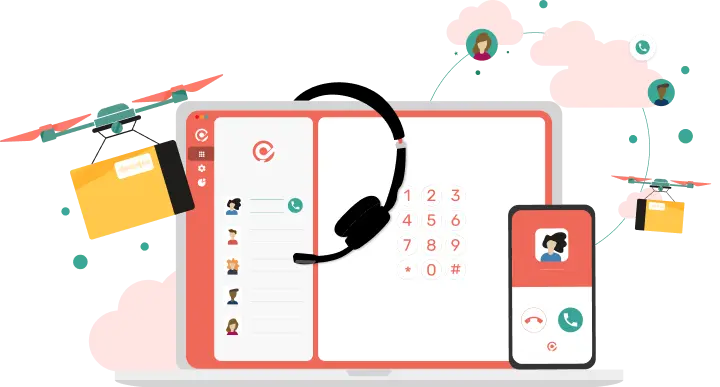
Session Initiation Protocol (SIP): The Ultimate Guide
Session initiation protocol, known as SIP, is an important part of any cloud phone system and a phrase you’re likely to hear bandied about when researching your new business phone system.
SIP works hand in hand with voice over internet protocol (VoIP), to make your calls happen, and we’re going to cover the basics of how it does just that.
Session Initiation Protocol
What exactly is SIP?
SIP is Session Initiation Protocol and it’s the term used in telephony to describe the protocols which enable VoIP and initiates a voice or media session by defining the messages that are actually sent between two endpoints.
That sounds like a lot to get your head around, doesn’t it? What you need to know is that SIP will enable a call that’s being performed over VoIP to happen. While VoIP actually transfers the voice packets over the internet, SIP makes this possible. SIP establishes the session in the first place, allowing a direct connection between a private phone system and the public network.
Usage
What is SIP used for?
SIP, as clarified above, is used to establish connections and begin a session for multimedia communications to take place. But that’s not the only thing SIP is used for.
In addition to initiating the session, managing the signal and terminating the session, SIP is used to:
- Check user location & participation - SIP will be notified of a telephone’s location and then it will determine which endpoints are going to be in the call.
- Determine user availability - SIP is the protocol that determines whether a user will answer your call.
- Check the capabilities of participants - when you’re calling using different systems, SIP negotiates the codec you’re using to make sure each user is supported.
- Initiate the session and start your phone ringing - the absolute basic setup is SIP telling the other endpoint that it should be ringing, but it will also set up other session attributes for both caller and callee.
- Manage the needs of your session - during a call its SIP that will assist with any changes you need to make. Things like call transferring, call termination or adding another person to the call.

Sip & Voip
How does SIP work with VoIP?
VoIP and SIP work hand in hand. While VoIP can be used without SIP as there are a number of other protocols that can be used, it’s by far the most popular combination for voice communication.
When a VoIP system uses SIP it does it like this: SIP establishes the initial connection that VoIP will use to transfer its voice packets by connecting one SIP address to another SIP address.
There’s more to it than this, and it uses a number of different protocols. These include session description protocol (SDP), real-time transport protocol (RTP), RTP control protocol (RTCP), transmission control protocol (TCP) and user datagram protocol (UDP). These all work with SIP and VoIP to make calls possible.
requirements & Sip trunking
What are the requirements for SIP & what is SIP trunking?
There are just a couple of simple things you need to run a SIP-telephony system. First of all, you’ll need an internet connection. That’s the simplest bit. Once you’ve got that sorted you’ll need either a private branch exchange (PBX) that’s been SIP-enabled or a VoIP phone system and, finally, an SIP service provider.
The SIP provider will then need to install your SIP trunk. The term ‘trunk’ may be familiar to people who have an understanding of older phone systems. For those phone systems, it referred to a collection of shared phone lines. An SIP trunk has a similar philosophy though.
An SIP trunk is the link between your PBX and the public switched telephone network (PSTN). It essentially allows you to remove your traditional phone lines and use a virtual SIP trunk in its place.
Circleloop's
SIP Glossary
At CircleLoop we’re on a mission to make the world of cloud-based phone systems clear. We want to help you understand the jargon and acronyms that get thrown about regularly in the industry. In terms of SIP, there are a number of terms you need to be aware of.
SIP
SIP, or Session Initiation Protocol, is a signalling protocol that’s used to establish VoIP communications.
VoIP
VoIP, or Voice over Internet Protocol, is the technology that uses SIP, and other protocols, to convert voice to data packets, transfer it and then turn it back into voice at the other end.
PBX
Otherwise known as a private branch exchange. Essentially it’s an office phone network. It’s what lets you port calls around your organisation.
RTP & SRTP
Short for (secure) real-time transport protocol. It’s the internet protocol that transmits your voice data packets. The secure version encrypts your data.
IP
The ‘internet protocol’ that provides the rules for transmitting data online. It’s these rules, which are standardised, that allow mismatching platforms to communicate. For instance, an app-based phone communicating with a physical phone.
SDP
Standing for Session Description Protocol, SDP is a format for describing multimedia communication sessions for the purposes of session invitation and announcement.
TCP
Transmission Control Protocol, TCP, is a common protocol in networks that use IP. It facilitates the exchange of messages between devices in a network.
UDP
Otherwise known as User Datagram Protocol, UDP allows applications to send messages known as datagrams to other applications on an IP network.
Are you ready?
Start your 7 day free trial today.
Set-up in minutes, no credit card required.
